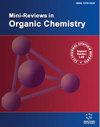Biological Activities of Aurones: A Brief Summary
IF 1.9
4区 化学
Q2 CHEMISTRY, ORGANIC
引用次数: 0
Abstract
: Aurones are structural isomers of flavones and flavonols with the basic C6–C3–C6 skeleton arranged as (Z)-2-benzylidenebenzofuran-3(2H)-one, which contain an exocyclic carbon-carbon double bond bridging the benzofuranone and phenyl rings. In aurone, a chalcone-like group is closed into a 5-membered ring instead of the 6-membered ring more typical of flavonoids, which forms the core for a family of derivatives that are known collectively as aurones. As a kind of flavonoids, aurones are widely distributed in many plants which provide yellow color to some popular ornamental flowers. For a long time aurones had not got enough attention, while in recent years, finally this chemical is coming into researchers' view. As the secondary metabolite in the family of flavonoids, aurones displayed various biological activities, including antioxidant, antiparasitic, antitumor, antiviral, antibacterial, anti-inflammatory, anti-SARS-CoV-2 and neuropharmacological activities. Therefore, aurones have attracted the attention of more and more chemists and pharmaceutical chemists, who realized that it is possible to get lead compounds with better activities via structural modifications of aurones. In some research works, aurone and its derivatives have exhibited good activity, e.g., Xie discovered the heterocyclic variant of the (Z)-2-benzylidene-6-hydroxybenzofuran-3(2H)- one scaffold that possessed low nanomolar in vitro potency in cell proliferation assays using various cancer cell lines, in vivo potency in prostate cancer PC-3 xenograft and zebrafish models, and absence of appreciable toxicity, which proved that aurones are valuable compounds worthy of further study. Herein, the biological activities of aurone derivatives are reviewed, which covers the literature since 2000, in which the strategies to develop bioactive aurone derivatives and the structureactivity relationship are highlighted.Aurones 的生物活性:简述
:枳酮是黄酮和黄酮醇的结构异构体,其基本的 C6-C3-C6 骨架排列为 (Z)-2-亚苄基苯并呋喃-3(2H)-酮,其中含有一个连接苯并呋喃酮环和苯基环的外环碳碳双键。在醛酮中,类似查耳酮的基团被封闭成一个 5 元环,而不是类黄酮更常见的 6 元环,这就形成了统称为醛酮的衍生物家族的核心。作为黄酮类化合物的一种,枳壳酮广泛分布于许多植物中,为一些常见的观赏花卉提供了黄色。长期以来,枳壳酮一直没有得到足够的重视,而近年来,这种化学物质终于进入了研究人员的视野。作为黄酮类化合物家族中的次级代谢产物,枳壳酮具有多种生物活性,包括抗氧化、抗寄生虫、抗肿瘤、抗病毒、抗菌、抗炎、抗 SARS-CoV-2 和神经药理活性。因此,呋喃酮引起了越来越多化学家和药物化学家的关注,他们意识到通过对呋喃酮进行结构改造,有可能获得具有更好活性的先导化合物。在一些研究工作中,醛酮及其衍生物表现出了良好的活性,例如Xie发现了(Z)-2-亚苄基-6-羟基苯并呋喃-3(2H)-1支架的杂环变体,该变体在体外使用多种癌细胞株进行细胞增殖实验时具有低纳摩尔的效力,在体内使用前列腺癌PC-3异种移植和斑马鱼模型时具有效力,并且没有明显的毒性,这证明枳酮是值得进一步研究的有价值的化合物。本文综述了 2000 年以来有关醛酮衍生物生物活性的文献,其中重点介绍了开发具有生物活性的醛酮衍生物的策略和结构-活性关系。
本文章由计算机程序翻译,如有差异,请以英文原文为准。
求助全文
约1分钟内获得全文
求助全文
来源期刊
CiteScore
4.50
自引率
4.30%
发文量
116
审稿时长
>12 weeks
期刊介绍:
Mini-Reviews in Organic Chemistry is a peer reviewed journal which publishes original reviews on all areas of organic chemistry including organic synthesis, bioorganic and medicinal chemistry, natural product chemistry, molecular recognition, and physical organic chemistry. The emphasis will be on publishing quality papers very rapidly, without any charges.
The journal encourages submission of reviews on emerging fields of organic chemistry including:
Bioorganic Chemistry
Carbohydrate Chemistry
Chemical Biology
Chemical Process Research
Computational Organic Chemistry
Development of Synthetic Methodologies
Functional Organic Materials
Heterocyclic Chemistry
Macromolecular Chemistry
Natural Products Isolation And Synthesis
New Synthetic Methodology
Organic Reactions
Organocatalysis
Organometallic Chemistry
Theoretical Organic Chemistry
Polymer Chemistry
Stereochemistry
Structural Investigations
Supramolecular Chemistry

 求助内容:
求助内容: 应助结果提醒方式:
应助结果提醒方式:


